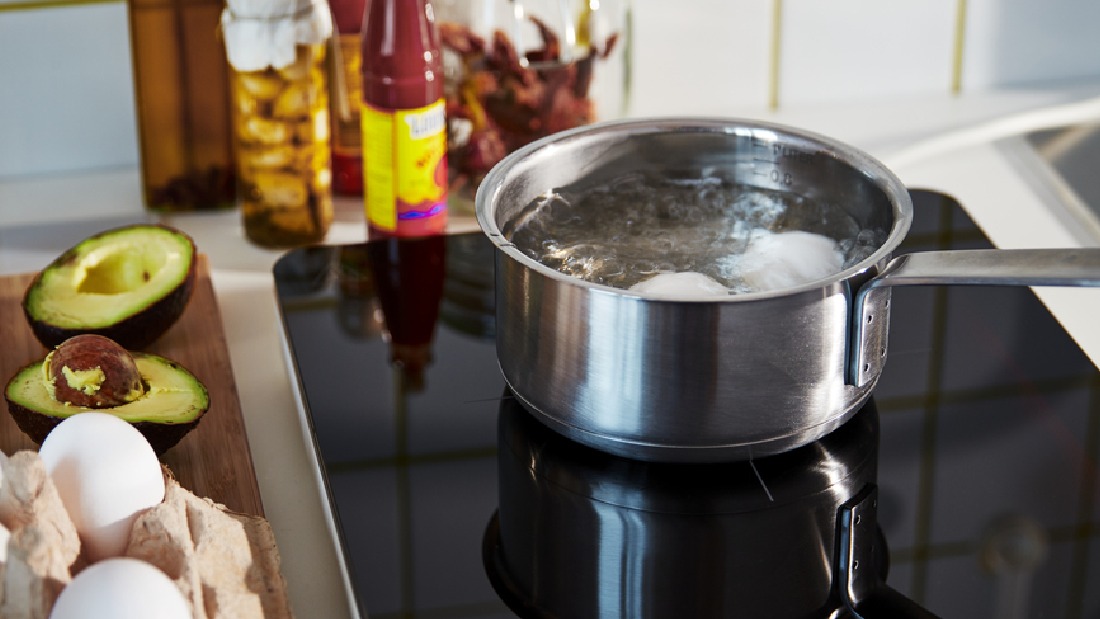While both types have their advantages, it's important to understand the fundamental differences between them to make an informed decision. Here are 5 key differences between induction and electric hobs, from how they operate to the costs involved in choosing one for your kitchen.
Heating Method
Electric hobs use electric current flowing through metal coils beneath a glass or ceramic surface to generate heat through electrical resistance. This heat is transferred to the cookware via direct contact with the hob's surface.
In contrast, induction hobs use a magnetic field generated by copper coils. When electric current flows through these coils, the magnetic field directly heats ferrous or steel cookware, without heating the hob's surface itself.
Induction hobs excel in terms of heating speed and energy efficiency, as the heat is generated directly in the cookware. Additionally, the surface cools quickly after being turned off, reducing the risk of accidents.
On the other hand, electric hobs offer convenience, especially since there is no open flame, making them safer compared to gas hobs and reducing the risk of burns. However, the heating speed of electric hobs may not be as fast as induction hobs.
Also Read: A quirky and personalized kitchen in a modern studio for work and play
Energy Efficiency
Induction hobs operate using electricity to generate heat without needing a flame, making them more efficient compared to both gas and electric hobs.
Induction hobs can utilize up to 90% of electrical energy for cooking, resulting in faster heating and minimizing wasted energy. This efficiency also leads to significant long-term cost savings. Electric hobs typically use between 1,000 and 3,000 watts.
If used for 7 hours per week, an electric hob can consume approximately 1,022 kilowatt-hours (kWh) per year. This consideration is important when choosing a hobs that fits your needs and budget.
Safety
Both electric and induction hobs offer improved safety compared to gas hobs, as they do not require a gas line to ignite a flame, reducing the risks of gas leaks and fires.
However, induction hobs have an added safety advantage, especially for households with children. Induction hobs only heat the pots or pans on the surface, leaving the surrounding area cool and safe to touch.
Induction hobs use electromagnetic fields to heat the cookware directly, unlike electric hobs, which heat the surface first. This keeps the induction hobs surface cool to the touch, lowering the risk of burns and making it a safer choice for families.
Also Read: A traditional black kitchen in a small space
Maximum Temperature
Electric and induction hobs have significant differences in the maximum temperatures they can achieve, affecting your cooking process. Electric hobs can reach a maximum temperature of around 393 degrees Celsius.
Temperature settings on electric hobs take about 15 minutes to reach the desired level, with options such as low, medium, and high.
In contrast, induction hobs can reach a maximum temperature of about 351 degrees Celsius, with portable models typically reaching 270-280 degrees Celsius. Although the maximum temperature of induction hobs is slightly lower, these hobs are faster in reducing temperatures after use.
Price
Induction hobs generally have a higher initial cost compared to electric hobs. However, induction hobs are often considered more energy-efficient than gas hobs, providing long-term savings.
Induction hobs use more advanced technology and are often more durable. For example, if you use an induction hob with a power rating of 900 VA and consume around 60-70 kWh per month, the electricity cost would range from IDR 36,300 to IDR 42,350.
On the other hand, more affordable electric hobs use simpler technology but require higher electrical power, which can increase monthly operational costs.
Also Read: How to organise your countertop to have everything close by
Choosing the Right Cooktop for Your Kitchen


